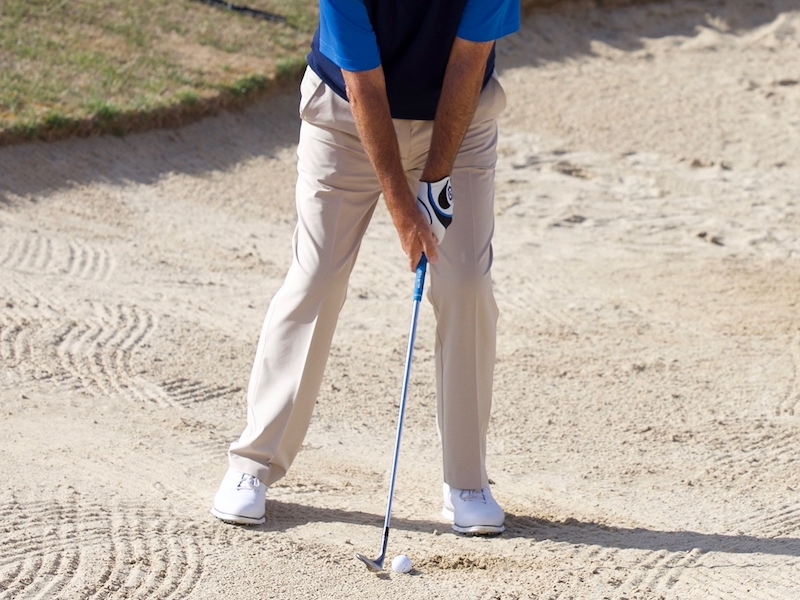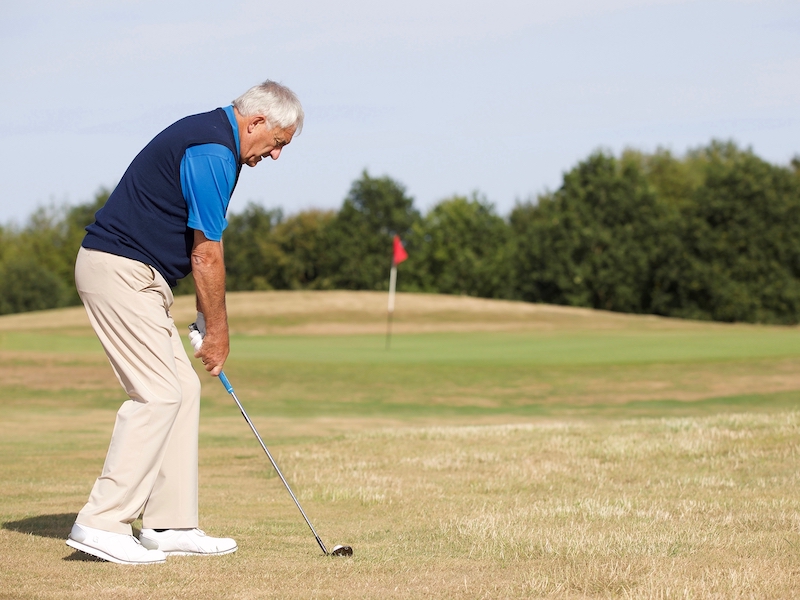Top 10 Senior Golf Tips
Peter Dawson, former Ryder Cup player and author of Now for the Back Nine aimed at senior players, offers his top ten tips for senior golfers


Peter Dawson, former Ryder Cup player and author of Now for the Back Nine aimed at senior players, offers his top ten tips for senior golfers
Top 10 Senior Golf Tips
The mechanics and movement of the modern swing, which is much more physically demanding than in days gone by, are difficult, if not impossible, with a stiff back, dicky knees and old war wounds. Yet few golf books show any understanding of how to adapt modern teaching to us old ‘uns.
My Ryder Cup singles opponent, Don January - a great player with a wonderful swing - explained to me over a post-match cup of tea that as he got older and his physique and body changed, it required him to adjust his swing every two or three years because of…
1) Reduced strength and limited flexibility – as our strength and ease of movement diminish, we must adapt to get the distance we need, especially off the tee. And 2) Bad habits – these creep in as we seek to compensate.
So, it comes down to making the most of what we have, what we know and how we use our experience. Here are ten ideas for senior golfers to try from my new book, Now for the Back Nine...
1. ‘Less is more’ By this, I mean less back and more through in the swing. The diminishing ability to turn back need not affect the power of your swing. As with throwing the ball, the power lies in the follow-through. Poor follow-throughs are often the consequence of what has gone before. There can be a misguided belief that a bigger shoulder turn on the way back means more distance. It doesn’t - it usually means more chance of something going wrong.
Subscribe to the Golf Monthly newsletter to stay up to date with all the latest tour news, equipment news, reviews, head-to-heads and buyer’s guides from our team of experienced experts.

You can influence and improve your follow-through with slight changes to your stance and ball position. Try opening your front foot by up to 30% to achieve a wider, fuller follow-through, and consider walking after the ball after impact.

2. Extending the circle of power Loss of full movement causes a loss of turn and power. To overcome this, find a better way to transfer your weight. I like to refer to this as creating an extended circle of power. You can achieve this by shifting virtually all your weight onto your back foot on your backswing and then reversing that shift down and through the ball on your follow-through.
Just as with throwing a ball, the weight moves from back to front foot as your hips and chest rotate through the ball until they are well ahead of their address position.

3. Hybrids for the senior golfer You only need look at the images of the 1970’s 3-iron next to the latest hybrid to see why, for so many of us, hybrids have replaced long irons. Not only are they much easier to hit, but they also have so many more uses, such as playing out of the semi-rough, chipping and even long bunker shots.

When swinging, imagine you’re sweeping the ball away as you would a fairway wood, with the ball position slightly further back in the stance creating a slightly downward swing and a shallow divot.
4. Favour the chip and run Unless you have an obstacle to go over, such as rough or a bunker, always take the easy option and run the ball in. It is so much easier to control. Personally, I use my hybrid as I find the shape of the head makes it so much easier to achieve a consistent strike.

Remember that hybrids are a little longer than mid-irons, so be careful not to grip too high as the shorter the grip, the better the feel. As with all shots, be sure to take a good posture and stand tall, with most of your weight on your front foot and the ball positioned in the middle of your stance.
5. The greenside splash shot The perfect bunker shot is a rhythmic explosion. It’s all about set-up and follow-through. Whatever your technique, if you set up correctly and attack the sand with your follow-through, the ball will come out. Most failures are caused by quitting on the shot.

Having your weight more on your front foot creates a slightly steeper downswing, enabling you to take the sand first and then the ball, leaving the club to do the work. Never try to lift the ball out of the bunker by flicking the hands at impact. When deciding how hard to hit a bunker shot, Jack Nicklaus advises imagining that the shot you’re playing is twice as far as it would be if chipping from grass.
6. Chipping technique To chip well, I recommend keeping weight constant throughout with at least 60% on your front foot. The hands should work as one unit, with no flicking movement from the bottom hand. Grip two to three inches down the shaft for more control and pick the spot where you want the ball to land.

Then create a pendulum movement, with the backswing the same length as the follow-through. Most poor chipping is caused by too much leg movement. This should be minimal throughout with the swing being driven solely by the arms and shoulders.
7. Putting Good posture is essential to provide the solid platform you need to putt consistently well. Bend primarily from the waist so your spine and shoulders can create a pendulum movement without moving the rest of the body. At address, your eyes should be over the ball, or as close as possible, with the ball fractionally forward of centre to ensure a slightly upward strike.

As we get older, more putts are missed through poor alignment, so here are some ideas to try: a) Line up the putterhead first. Take up your stance when you’re happy the putter is lined up correctly. b) As we age, one eye can become weaker than the other – experiment by closing each eye in turn to work out which eye works best for you. c) Check your shoulders are square to the line - choose a spot on your chosen line and aim for it.
8. Hit the wall to improve impact The idea here is very straightforward as it replicates the position you should be in when you strike the ball. Stand with your leading foot against the wall. Take your normal backswing and return to hit the wall (gently of course!) making sure that your chest is facing the wall on impact. This enables you to feel the correct position of the shoulders and chest at impact.

The proximity of the wall highlights any incorrect movements that you make during your backswing as you will find it difficult, if not impossible, to return to the correct impact position. Why not try to make this movement part of your pre-shot routine or at least visualise the movement during your practice swing?
9. Eliminating excess leg movement on chips To help eliminate excess leg movement, take your normal stance, then move your back foot 12in behind your front foot. Your weight is now automatically advanced onto your front leg. Swing back with your hands and arms, keeping your top arm straight.

Notice how much easier it is to take the club back with your hands and arms. Swing down and through, keeping your lower arm straight and your head and chest following through towards the target.
10. Drill to prevent shanking Take a wedge and extend the shaft with an alignment stick. Grip the club with the extension resting against your front side. Swing back and through ensuring that the shaft extension doesn’t leave your side.

This ensures that your hands stay ahead of the clubhead and your body turns correctly, stopping your from flicking the club at impact with your hands. Your head and chest follow as you swing through.
Signed copies of Now for the Back Nine by Peter Dawson and Simon Hawkins are available for £20 at nowforthebacknine.co.uk. It is also available on Amazon.
Expand 4 Putting Drills Guaranteed To Lower Your Scores

4 Putting Drills Guaranteed To Lower Your Scores
Struggling with confidence on the greens?
Expand 4 Chipping Drills Guaranteed To Lower Your Scores

4 Chipping Drills Guaranteed To Lower Your Scores
Do you struggle with chipping? GM Top 25…
Expand 4 Tour Pro Iron Play Drills Guaranteed To Improve Your Striking

4 Tour Pro Iron Play Drills Guaranteed To Improve Your Striking
Englishman Paul Waring picks out four drills to…
For all the latest golf news, check the Golf Monthly website and follow our social media channels

Jeremy Ellwood has worked in the golf industry since 1993 and for Golf Monthly since 2002 when he started out as equipment editor. He is now a freelance journalist writing mainly for Golf Monthly. He is an expert on the Rules of Golf having qualified through an R&A course to become a golf referee. He is a senior panelist for Golf Monthly's Top 100 UK & Ireland Course Rankings and has played all of the Top 100 plus 91 of the Next 100, making him well-qualified when it comes to assessing and comparing our premier golf courses. He has now played 1,000 golf courses worldwide in 35 countries, from the humblest of nine-holers in the Scottish Highlands to the very grandest of international golf resorts. He reached the 1,000 mark on his 60th birthday in October 2023 on Vale do Lobo's Ocean course. Put him on a links course anywhere and he will be blissfully content.
Jezz can be contacted via Twitter - @JezzEllwoodGolf
Jeremy is currently playing...
Driver: Ping G425 LST 10.5˚ (draw setting), Mitsubishi Tensei AV Orange 55 S shaft
3 wood: Srixon ZX, EvenFlow Riptide 6.0 S 50g shaft
Hybrid: Ping G425 17˚, Mitsubishi Tensei CK Pro Orange 80 S shaft
Irons 3- to 8-iron: Ping i525, True Temper Dynamic Gold 105 R300 shafts
Irons 9-iron and PW: Honma TWorld TW747Vx, Nippon NS Pro regular shaft
Wedges: Ping Glide 4.0 50˚ and 54˚, 12˚ bounce, True Temper Dynamic Gold 105 R300 shafts
Putter: Kramski HPP 325
Ball: Any premium ball I can find in a charity shop or similar (or out on the course!)